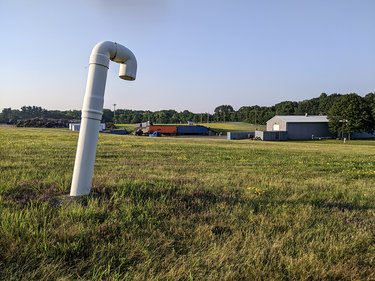Rensselaerville surprised to learn that old landfill is undergoing state assessment
RENSSELAERVILLE — A robust state initiative to assess the potential impacts of old landfills on water quality came to light in Rensselaerville only after the town board began preliminary discussions of turning its own former Kenyon Road landfill into a memorial park.
The New York State Department of Environmental Conservation told The Enterprise earlier this month that it had ordered the closure of the town’s landfill in December 1985, part of a wave of local landfill closures. The department received the required closure plans from the town in May 1986, and is currently investigating the site as part of its Inactive Landfill Initiative, which has its roots in the Clean Water Infrastructure Act of 2017.
When asked if town officials were aware of this, Town Clerk Victoria Kraker told The Enterprise earlier this month that it was the first time she had heard about it and that it “could change everything” about the town’s plans to convert the land.
This week, Kraker told The Enterprise that she had not learned anything new about the assessment since she first spoke with the paper and that she did not believe the DEC had been in touch with any other town official.
The matter did not come up at the town board’s July 10 workshop meeting, from which Supervisor John Dolce was absent.
The assessment is one of more than 1,000 being proactively conducted by the state, and does not reflect any specific concerns about the Rensselaerville landfill.
A 2o24 status report for the initiative shows that the state had begun preliminary investigations into 1,211 sites and completed 503 of them as of March of last year. Depending on the findings, sites are placed into one of four different priority groups, depending on if contaminant levels exceed criteria, and if there’s an impact to drinking-water wells.
The majority of landfill sites already investigated — 154 — fall into the lowest priority group, with no exceedances or impact to drinking water. This is followed closely by the second-highest priority group — 148 sites — where there are exceedances but no impact to drinking water.
Although part of a different program, The Enterprise reported in 2017 that the DEC had determined the former landfill in Guilderland’s Northeastern Industrial Park was contaminating groundwater there with three different toxic chemicals, resulting in the area becoming industrial-only with a prohibition on groundwater use.
Other localities have had better luck: Delmar and Westerlo each had landfills that fell in the lowest priority group.
It is unclear whether or how the assessment may affect Rensselaerville’s tentative plan to convert the land, which is still in a very early phase. The DEC did not respond to Enterprise inquiries in time for publication this week about when the assessment started, if any kind of negative finding would prevent such a project, and why there had apparently been no notification to the town about the assessment.
The DEC had told The Enterprise earlier this month that Rensselaerville would not be alone should the town turn its former landfill into a park, citing Blatnick Park in Niskayuna and sports fields on Frisbie Avenue in the city of Albany as examples of other successful conversions.

